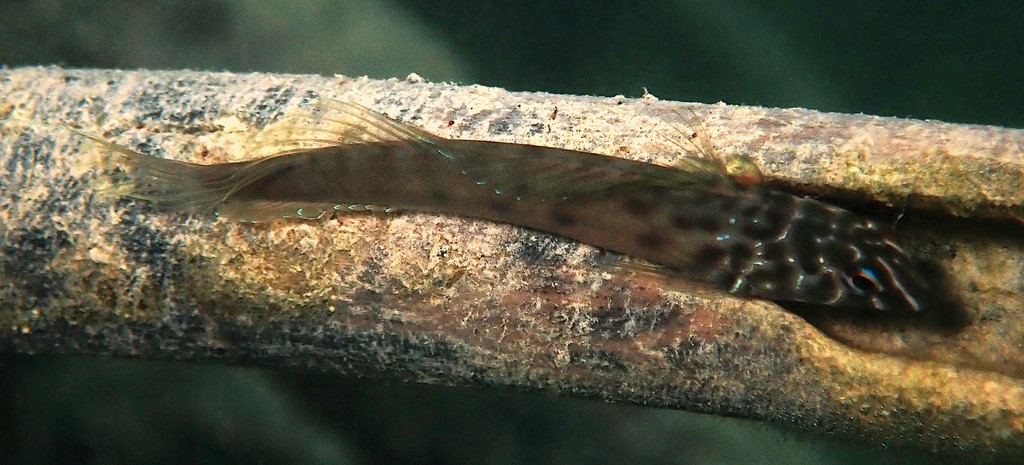OMOX BIPOROS - (SPRINGER, 1972)
Picture courtesy of: Alain Daoulas
Actinopterygii (Gigaclass) > Actinopteri (Class) > Teleostei (Subclass) > Blenniiformes (Order) > Blennioidei (Suborder) > Blenniidae (Family) > Blenniinae (Subfamily) > Omox (Genus)
Omox blenny, Two-holed blenny, Doublepore blenny, Hirugiginpo, ヒルギギンポ, 似肩鰓鳚,
Description
Dorsal spines (total): 12; Dorsal soft rays (total): 15-17 (usually: 16); Anal spines: 2; Anal soft rays: 17-19; Pectoral fin rays: 13; Pelvic fins rays: I, 2; Caudal fin rays (dorsal procurrent rays-segmented rays-ventral procurrent rays) 5 to 6-13-5 to 6; Vertebrae: 10 + 24-26; Pleural ribs on vertebrae: 3-10; Epipleural ribs on vertebrae 1-12 or 13; Upper jaw teeth: I-20-I to I-25-I; Lower jaw teeth: I-19-I to I-26-I. Dorsal fin origin slightly in advance of level of gill opening, notched slightly above last one or two spines; Tips of caudal fin rays and posterior dorsal fin rays filamentous in mature males only; Lateral line absent on body. No cirri on head; Dorsal and anal fins not attached to caudal fin; Frontal bones separate in adults; 4 circumorbital bones, kinethmoid present; Postcleithra normal; Ventral hypural plate autogenous; Nasal bones separate; 8 (rarely: 7 unilaterally) sensory pores in circumorbital series; 3 sensory pores in mandibular series; 13 sensory pores in supratemporal-preoperculo-mandibular series; 4 (rarely: 3) interorbital sensory pores; Posterior nostril present, normal; Gill opening extending ventrally to opposite level of 8th to 11th from dorsalmost pectoral fin ray; shortest pelvic fin ray more than half length of longest. Max. length: 4.6 cm SL. Depth range: 0 - 3 m.
Color
Dark brown with black blotches on the sides and black bars on the head, and clear fins
Etymology
Omox: an arbitrary combination of letters. Referring to its similarity to Omobranchus.
biporos: from Latin adverb, bis = two or twice + from Latin, póros = a pore on the skin. Referring to two sensory pores that appear, one on each side, just anterior to dorsal-fin origin.
Original description: Omox biporos Springer, 1972 - Type locality: Southeast bay of Goh Mak Island, southwest of Trat Bay, 11°48'15"N, 102°29'08"E, east coast of Gulf of Thailand. Collected by H.A. Fehlmann, et al., 30 October 1957.
Distribution
Western Pacific: Australia and New Caledonia north to Ryukyu Islands (Japan); Throughout most of the East Indian region.
Biology
A rare species, living among the roots of mangrove trees. Also found in estuaries and stream mouths. Oviparous. Eggs are demersal and adhesive, and are attached to the substrate via a filamentous, adhesive pad or pedestal. Larvae are planktonic, often found in shallow, coastal waters.
Last update: 17, March 2023
Actinopterygii (Gigaclass) > Actinopteri (Class) > Teleostei (Subclass) > Blenniiformes (Order) > Blennioidei (Suborder) > Blenniidae (Family) > Blenniinae (Subfamily) > Omox (Genus)
Omox blenny, Two-holed blenny, Doublepore blenny, Hirugiginpo, ヒルギギンポ, 似肩鰓鳚,
Description
Dorsal spines (total): 12; Dorsal soft rays (total): 15-17 (usually: 16); Anal spines: 2; Anal soft rays: 17-19; Pectoral fin rays: 13; Pelvic fins rays: I, 2; Caudal fin rays (dorsal procurrent rays-segmented rays-ventral procurrent rays) 5 to 6-13-5 to 6; Vertebrae: 10 + 24-26; Pleural ribs on vertebrae: 3-10; Epipleural ribs on vertebrae 1-12 or 13; Upper jaw teeth: I-20-I to I-25-I; Lower jaw teeth: I-19-I to I-26-I. Dorsal fin origin slightly in advance of level of gill opening, notched slightly above last one or two spines; Tips of caudal fin rays and posterior dorsal fin rays filamentous in mature males only; Lateral line absent on body. No cirri on head; Dorsal and anal fins not attached to caudal fin; Frontal bones separate in adults; 4 circumorbital bones, kinethmoid present; Postcleithra normal; Ventral hypural plate autogenous; Nasal bones separate; 8 (rarely: 7 unilaterally) sensory pores in circumorbital series; 3 sensory pores in mandibular series; 13 sensory pores in supratemporal-preoperculo-mandibular series; 4 (rarely: 3) interorbital sensory pores; Posterior nostril present, normal; Gill opening extending ventrally to opposite level of 8th to 11th from dorsalmost pectoral fin ray; shortest pelvic fin ray more than half length of longest. Max. length: 4.6 cm SL. Depth range: 0 - 3 m.
Color
Dark brown with black blotches on the sides and black bars on the head, and clear fins
Etymology
Omox: an arbitrary combination of letters. Referring to its similarity to Omobranchus.
biporos: from Latin adverb, bis = two or twice + from Latin, póros = a pore on the skin. Referring to two sensory pores that appear, one on each side, just anterior to dorsal-fin origin.
Original description: Omox biporos Springer, 1972 - Type locality: Southeast bay of Goh Mak Island, southwest of Trat Bay, 11°48'15"N, 102°29'08"E, east coast of Gulf of Thailand. Collected by H.A. Fehlmann, et al., 30 October 1957.
Distribution
Western Pacific: Australia and New Caledonia north to Ryukyu Islands (Japan); Throughout most of the East Indian region.
Biology
A rare species, living among the roots of mangrove trees. Also found in estuaries and stream mouths. Oviparous. Eggs are demersal and adhesive, and are attached to the substrate via a filamentous, adhesive pad or pedestal. Larvae are planktonic, often found in shallow, coastal waters.
Last update: 17, March 2023
